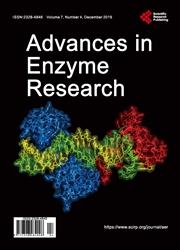Enhanced Production of Salinity-Induced Proteases from Aspergillus flavus and Aspergillus niger
引用次数: 3
Abstract
Proteases are important industrial enzymes that account for about 60% of the total enzyme market globally due to their large application in food, feed, textile and pharmaceutical industries. The effect of salt stress on protease production was evaluated on Aspergillus flavus and Aspergillus niger. The enzyme production was enhanced by stepwise optimization of the culture parameters, notably, carbon source, nitrogen source, pH, and temperature of the submerged fermentation process while using a minimal salt media and casein as substrate for the protease activity. The fungi species were found to be good producers of both acid and alkaline proteases under 4% salt stress condition. The optimum culture conditions for alkaline protease production by Aspergillus flavus were sucrose 4%, peptone 1%, pH 8 at 40°C with maximum enzymatic activities of 8.85 mM/min/mg protein, 5.22 mM/min/mg protein, 3.75 mM/min/mg protein, and 1.64 mM/min/mg protein, respectively. Lactose 4%, peptone 1%, pH 6 at 50°C were the optimum culture conditions for acid protease production by Aspergillus flavus with maximum enzymatic activities of 4.59 mM/min/mg protein, 2.06 mM/min/mg protein, 1.24 mM/min/mg protein, and 1.23 mM/min/mg protein, respectively. For Aspergillus niger, the optimum culture conditions for alkaline protease production were corn starch 4%, yeast extract 1%, pH 6 at 40°C with maximum enzymatic activities of 5.99 mM/min/mg protein, 3.85 mM/min/mg protein, 6.18 mM/min/mg protein, and 3.72 mM/min/mg protein, respectively. While lactose 4%, yeast extract 1%, pH 6 at 50°C were the best culture conditions for acid protease production by Aspergillus niger with maximum enzymatic activities of 4.81 mM/min/mg protein, 0.93 mM/min/mg protein, 5.71 mM/min/mg protein, and 3.34 mM/min/mg protein, respectively.提高黄曲霉和黑曲霉盐诱导蛋白酶的产量
蛋白酶是重要的工业酶,由于其在食品、饲料、纺织和制药行业的广泛应用,约占全球酶总市场的60%。研究了盐胁迫对黄曲霉和黑曲霉蛋白酶产量的影响。通过逐步优化培养参数,特别是碳源、氮源、pH和温度,以最低盐培养基和酪蛋白作为蛋白酶活性的底物,提高了酶的产量。结果表明,在4%盐胁迫条件下,这两种真菌都能很好地产生酸蛋白酶和碱性蛋白酶。黄曲霉产碱性蛋白酶的最佳培养条件为:蔗糖4%,蛋白胨1%,pH 8, 40℃,最大酶活性分别为8.85 mM/min/mg蛋白,5.22 mM/min/mg蛋白,3.75 mM/min/mg蛋白和1.64 mM/min/mg蛋白。在乳糖4%、蛋白胨1%、pH 6、50℃条件下,黄曲霉产酸性蛋白酶的最佳条件分别为4.59 mM/min/mg蛋白、2.06 mM/min/mg蛋白、1.24 mM/min/mg蛋白和1.23 mM/min/mg蛋白。对黑曲霉而言,产碱性蛋白酶的最佳培养条件为玉米淀粉4%、酵母浸膏1%、pH 6、40℃,最大酶活性分别为5.99 mM/min/mg蛋白、3.85 mM/min/mg蛋白、6.18 mM/min/mg蛋白和3.72 mM/min/mg蛋白。而在乳糖4%、酵母浸膏1%、pH 6、50℃条件下,黑曲霉产酸性蛋白酶的最佳条件分别为4.81 mM/min/mg蛋白、0.93 mM/min/mg蛋白、5.71 mM/min/mg蛋白和3.34 mM/min/mg蛋白。
本文章由计算机程序翻译,如有差异,请以英文原文为准。
求助全文
约1分钟内获得全文
求助全文

 求助内容:
求助内容: 应助结果提醒方式:
应助结果提醒方式:


